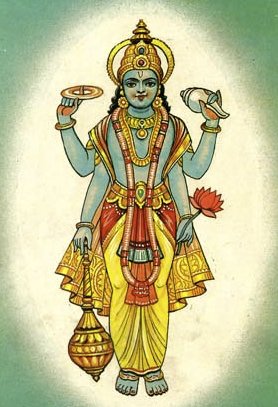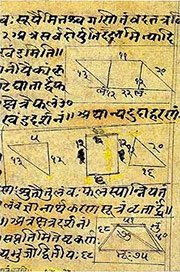Parardha, Parārdha, Para-ardha: 12 definitions
Introduction:
Parardha means something in Hinduism, Sanskrit, Marathi. If you want to know the exact meaning, history, etymology or English translation of this term then check out the descriptions on this page. Add your comment or reference to a book if you want to contribute to this summary article.
In Hinduism
Purana and Itihasa (epic history)
Source: Cologne Digital Sanskrit Dictionaries: The Purana IndexParārdha (परार्ध).—Measurement of ten antas, (Vedic): two Parārdhams constitute Brahmā's life (first Prajāpati);1 The present Varāhakalpa is the second Parārdha;2 of Brahmā;3 a crore of 1000 crores.4
- 1) Vāyu-purāṇa 100. 240. Viṣṇu-purāṇa I. 3. 5.
- 2) Ib. I. 3. 27-8; VI. 3. 4.
- 3) Brahmāṇḍa-purāṇa I. 4-31.
- 4) Vāyu-purāṇa 101. 92, 99.

The Purana (पुराण, purāṇas) refers to Sanskrit literature preserving ancient India’s vast cultural history, including historical legends, religious ceremonies, various arts and sciences. The eighteen mahapuranas total over 400,000 shlokas (metrical couplets) and date to at least several centuries BCE.
Vaishnavism (Vaishava dharma)
Source: Pure Bhakti: Brhad BhagavatamrtamParārdha (परार्ध) refers to:—Half of Brahmā’s life. (cf. Glossary page from Śrī Bṛhad-bhāgavatāmṛta).

Vaishnava (वैष्णव, vaiṣṇava) or vaishnavism (vaiṣṇavism) represents a tradition of Hinduism worshipping Vishnu as the supreme Lord. Similar to the Shaktism and Shaivism traditions, Vaishnavism also developed as an individual movement, famous for its exposition of the dashavatara (‘ten avatars of Vishnu’).
Ganitashastra (Mathematics and Algebra)
Source: archive.org: Hindu Mathematics1) Parārdha (परार्ध) refers to a “trillion” (1,000,000,000,000) in various lists of numeral denominations, according to gaṇita (“science of calculation”) and Gaṇita-śāstra, ancient Indian mathematics and astronomy.—We can definitely say that from the very earliest known times, ten has formed the basis of numeration in India. While the Greeks had no terminology for denominations above the myriad (104), and the Romans above the milk (103), the ancient Hindus dealt freely with no less than eighteen denominations [e.g., parārdha]. Cf. Yajurveda-saṃhitā (Vājasanyī) XVII.2; Taittirīya-saṃhitā IV.40.11, VII.2.20.1; Maitrāyaṇī-saṃhitā II.8.14; Kāṭhaka-saṃhitā XVII.10, XXXIX.6; Anuyogadvāra-sūtra 142; Āryabhaṭīya II.2; Gaṇitasārasaṃgraha I.63-68.
2) Parārdha (परार्ध) also refers to a “hundred quadrillion” (100,000,000,000,000,000) according to Śrīdhara in the Triśatikā.

Ganitashastra (शिल्पशास्त्र, gaṇitaśāstra) refers to the ancient Indian science of mathematics, algebra, number theory, arithmetic, etc. Closely allied with astronomy, both were commonly taught and studied in universities, even since the 1st millennium BCE. Ganita-shastra also includes ritualistic math-books such as the Shulba-sutras.
Languages of India and abroad
Marathi-English dictionary
Source: DDSA: The Molesworth Marathi and English Dictionaryparārdha (परार्ध).—n (S) A half of the life-term of Brahma.
Source: DDSA: The Aryabhusan school dictionary, Marathi-Englishparārdha (परार्ध).—n A half of the life-term of Brahma.
Marathi is an Indo-European language having over 70 million native speakers people in (predominantly) Maharashtra India. Marathi, like many other Indo-Aryan languages, evolved from early forms of Prakrit, which itself is a subset of Sanskrit, one of the most ancient languages of the world.
Sanskrit dictionary
Source: DDSA: The practical Sanskrit-English dictionaryParārdha (परार्ध).—
1) the other part (opp. pūrvārdha); the latter half; दिनस्य पूर्वार्धपरार्धभिन्ना छायेव मैत्री खलसज्जनानाम् (dinasya pūrvārdhaparārdhabhinnā chāyeva maitrī khalasajjanānām) Bhartṛhari 2.6.
2) a particular high number; i. e. 1,,,,,; एकत्वादिपरार्धपर्यन्ता संख्या (ekatvādiparārdhaparyantā saṃkhyā) T. S.
Derivable forms: parārdham (परार्धम्).
Parārdha is a Sanskrit compound consisting of the terms para and ardha (अर्ध).
Source: Cologne Digital Sanskrit Dictionaries: Benfey Sanskrit-English DictionaryParārdha (परार्ध).— i. e. para-ardha, I. m. 1. The ulterior part, Mahābhārata 2, 1864. 2. The other part, Böhtl. Ind. Spr. 382. Ii. m. and n. 1. The number 100,000,000,000,000,000. 2. Fifty years of Brahman (half his supposed æon), [Bhāgavata-Purāṇa, (ed. Burnouf.)] 3, 11, 33. Iii. (inexactly), instead of parārdhya, adj. Most excellent, most beautiful, Mahābhārata 4, 2188.
Source: Cologne Digital Sanskrit Dictionaries: Cappeller Sanskrit-English DictionaryParārdha (परार्ध).—[masculine] the other or more remote side or half; the highest number (also [neuter]).
Source: Cologne Digital Sanskrit Dictionaries: Monier-Williams Sanskrit-English Dictionary1) Parārdha (परार्ध):—[from para] m. the more remote or opposite side or half, [Brāhmaṇa; Kaṭha-upaniṣad; Mahābhārata]
2) [v.s. ...] mn. the highest number (100,000 billions), [Vājasaneyi-saṃhitā; Taittirīya-saṃhitā; Mahābhārata] etc.
3) [v.s. ...] the number of mortal days corresponding to 50 years of Brahmā’s life, [Purāṇa]
4) [v.s. ...] mn. (as mfn. [wrong reading] for dhya.)
[Sanskrit to German]
Sanskrit, also spelled संस्कृतम् (saṃskṛtam), is an ancient language of India commonly seen as the grandmother of the Indo-European language family (even English!). Closely allied with Prakrit and Pali, Sanskrit is more exhaustive in both grammar and terms and has the most extensive collection of literature in the world, greatly surpassing its sister-languages Greek and Latin.
Kannada-English dictionary
Source: Alar: Kannada-English corpusParārdha (ಪರಾರ್ಧ):—[adjective] = ಪರಾರ್ಥ್ಯ [pararthya]1.
--- OR ---
Parārdha (ಪರಾರ್ಧ):—
1) [noun] the second half of a whole.
2) [noun] a very large number (used chiefly in mythology).
Kannada is a Dravidian language (as opposed to the Indo-European language family) mainly spoken in the southwestern region of India.
See also (Relevant definitions)
Starts with: Parardhaka, Parardhakalpa, Parardhamatra.
Ends with: Aparardha, Dakshinardhaparardha, Dviparardha, Tapahparardha.
Full-text (+1): Parardhya, Paripadmaka, Tapahparardha, Dviparardhika, Pararttacankai, Samkhya, Sapara, Tuvitiyapararttam, Tandava, Lakshi, Varahakalpa, Parai, Pararttam, Para, Parartha, Prakrita, Shveta Varaha Kalpa, Ardha, Catushpada, Ya.
Relevant text
Search found 31 books and stories containing Parardha, Parārdha, Para-ardha; (plurals include: Parardhas, Parārdhas, ardhas). You can also click to the full overview containing English textual excerpts. Below are direct links for the most relevant articles:
Amarakoshodghatana of Kshirasvamin (study) (by A. Yamuna Devi)
Education (9): Knowledge in Mathematics < [Chapter 4 - Cultural Aspects]
Brihad Bhagavatamrita (commentary) (by Śrī Śrīmad Bhaktivedānta Nārāyana Gosvāmī Mahārāja)
Verse 2.2.153 < [Chapter 2 - Jñāna (knowledge)]
Verse 2.2.230 < [Chapter 2 - Jñāna (knowledge)]
Verse 2.1.12 < [Chapter 1 - Vairāgya (renunciation)]
The Bhagavata Purana (by G. V. Tagare)
Chapter 11 - The concept of Time: Manvantaras and life-spans of Men and Gods < [Book 3 - Third Skandha]
Chapter 4 - The Four-Fold Pralaya < [Book 12 - Twelfth Skandha]
Chapter 32 - Excellence of the Bhaktiyoga < [Book 3 - Third Skandha]
The Brahma Purana (by G. P. Bhatt)
The Agni Purana (by N. Gangadharan)
Chandogya Upanishad (Madhva commentary) (by Srisa Chandra Vasu)